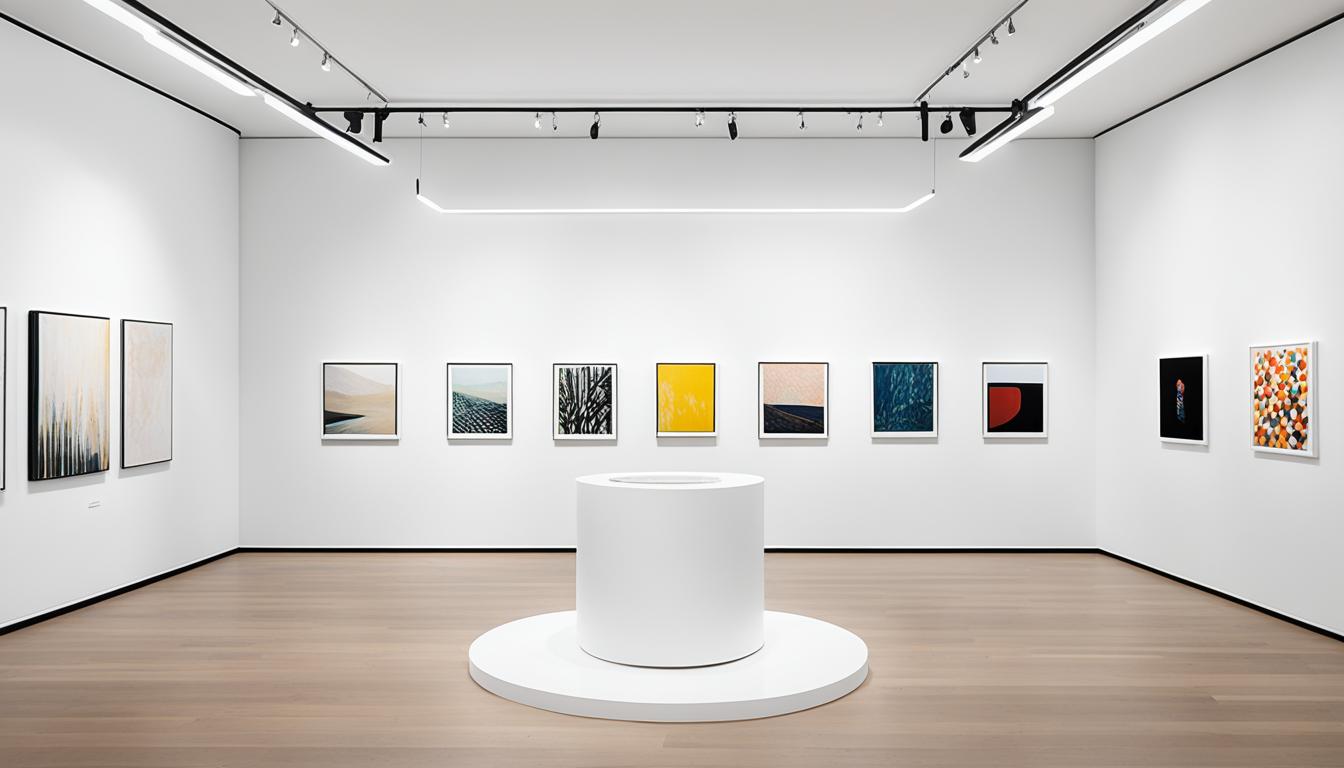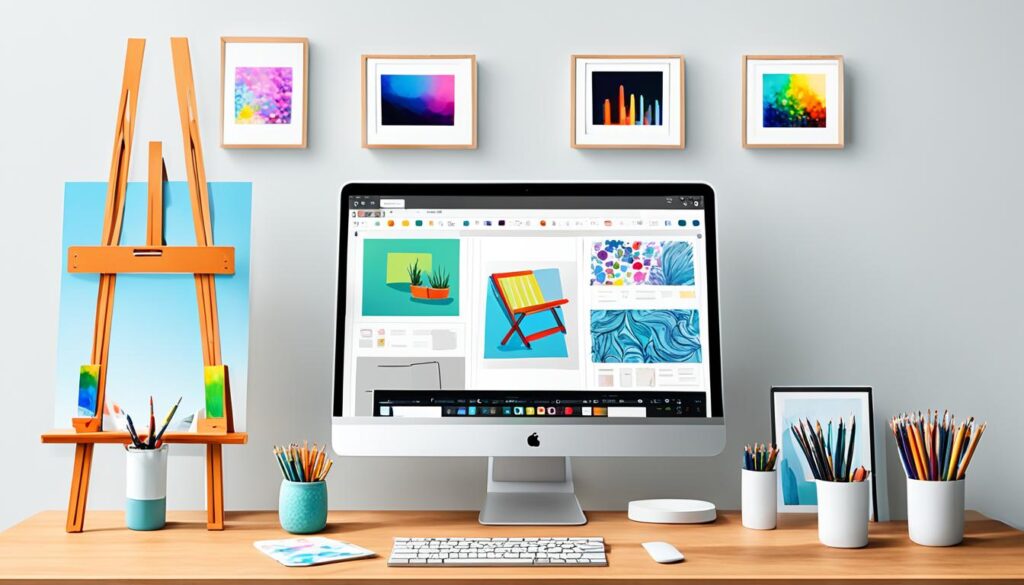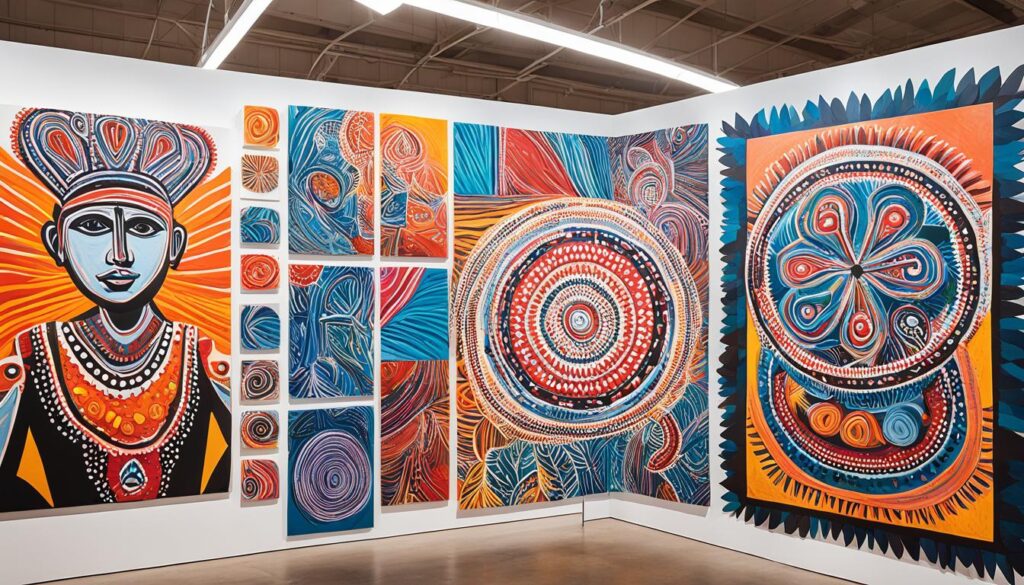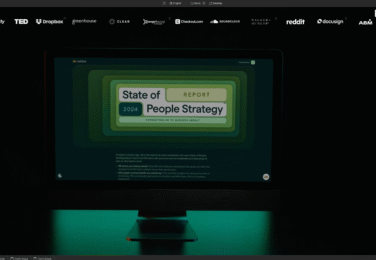Art Centres Transition to Ecommerce, Sell Artworks Online

Table of Content
“Art is the most intense mode of individualism that the world has known.” — Oscar Wilde
Art centres are moving to the online world. This change is very important. The Arts Law Centre of Australia says it’s crucial to be careful and ready. They point out key things like e-commerce insurance, safe transactions, and dealing with artworks from deceased estates. This advice is critical for a smooth move to ecommerce.
Donna Robinson, Chrischona Schmidt, and Jane Supit, three legal experts, offer important tips. They tell art centres to focus on key areas for a good digital shift. They say by going online, art centres can reach more people. They can also sell a wider range of artworks in their online shops.
Key Takeaways:
- Transitioning to ecommerce empowers art centres with broader reach and diverse offerings.
- Vigilance and preparation are crucial in addressing e-commerce insurance and secure transactions.
- Handling deceased estate artworks requires careful consideration and legal guidance.
- Legal experts Donna Robinson, Chrischona Schmidt, and Jane Supit provide valuable insights for a seamless digital transformation.
- Embracing ecommerce can revolutionise art centres by connecting them to a wider audience.
If you want to learn more about moving your art centre online, get in touch with us. You can reach us at 0298344119 or hello@defyn.com.au.
Why Art Centres Are Moving to Ecommerce
The way we sell art is changing fast. More and more, art centres are turning to online sales. This move is because selling online has many benefits compared to traditional methods.
Understanding the Shift
E-commerce started as just online catalogs. But now, it’s a rich shopping experience, perfect for art buyers and sellers alike1. It lets artists sell directly to anyone interested. New tech like virtual reality makes buying art a whole new experience1.
Benefits of Online Art Sales
One big plus of online art sales is reaching more people2. It lets art centres in the Northern Territory, for example, show their work to people worldwide. They can display everything from affordable prints to rare originals. This expands their market and brings in more income2.
Challenges in the Transition
But moving to online sales has its challenges. Some staff might need help to learn new digital skills2. Just like in any market, there’s a lot of competition online. Making it easy for customers to pay and check out is critical. It keeps the buying process smooth and customers happy2.
If you’re thinking of making the leap to online sales, we can help. Call us at 0298344119 or drop a line at hello@defyn.com.au.
Choosing the Right Ecommerce Platform for Art Centres
Art centres are venturing into the online art market. Picking the right ecommerce platform is key. It helps them sell and showcase their art. Platforms like Etsy and Shopify connect artists with global markets. They allow artists to control how they sell and distribute their art.
Popular Platforms
In 2024, Shopify and WordPress stand out in the digital market3. Shopify shines with its strong online selling features. WordPress is known for its design that suits artists and small businesses3. Shopify stands out by supporting over 100 payment options, including cryptocurrency. It has more than 3,000 apps and integrations to help boost sales4.
Shopify is loved for its easy-to-use interface and flexible features. These include customisable themes, secure infrastructure, and the ability to sell across multiple channels. It also has a range of apps in the Shopify App Store to enhance functionality3. However, it has some downsides. There are transaction fees, no email hosting, and limited customisation4.
Custom Solutions vs. Turnkey Platforms
Art centres must consider custom vs. turnkey solutions. Custom solutions match the centres’ unique needs better. Yet, they require more effort and resources. Turnkey platforms, like Shopify and Squarespace, are easier to set up3. They come with features designed for a broad range of users.
Shopify offers different plans, extensive customisation, and features for advanced selling and inventory management3. Squarespace, on the other hand, is best for those who value design. It provides elegant design options, easy editing, mobile-friendly sites, blogs, and ecommerce tools3.
When choosing a platform, art centres should consider their goals. This is especially important for events like the Darwin Art Festival (DAAF) or DesertMob. Whether they choose a custom setup or a ready-to-go platform, it’s crucial for their online success.
Building an Online Store for Art Centres
Designing a great online store for art centres mixes beautiful looks with easy use. It needs to draw in art fans and make buying or browsing a joy.
Website Design and User Experience
Online stores for art centres must be super easy to use. Platforms like Wix or Squarespace are great choices for this. They make it easy to see all the details of the art, making the visit nice for shoppers. Making the site your own also helps customers feel looked after. They can ask about pieces easily, which makes them more likely to buy.
Showcasing Artworks Effectively
Showing art online needs clear, high-quality pictures. This is so important to keep customers happy. With the right tools, like good design software, impressing buyers becomes doable. Also, remember, online art sales are growing fast, reaching about $23.79 billion by 20305. So, spending on good photography and clear descriptions is smart. An online shop lets art centres reach a bigger market. This boosts their sales and income2.
By going online, art centres can find new audiences and make up for lost foot traffic. They get to be seen more and talk to customers better. As demand for custom gifts grows to over $13 trillion by 20275, these shops can offer a broader range of items, not just art.
Art Centres and Ecommerce Transition, Online Selling Artworks, Merchandising
Art centres are moving towards online selling with platforms like Desart SAM. This step opens up a big market for artists. They now have a chance to sell their work to more people.
Artists can connect with buyers easily through online selling. This change allows consumers to enjoy art in their daily lives in new ways. Ownership of art now includes practical forms, making it more accessible.
This is good for both art fans and creators. It helps artists make more money, creating a win-win situation6.

The shift to art e-commerce is also connecting artists with fashion designers. Together, they’re making special fashion lines inspired by art. These art-inspired products are often made in limited runs, appealing to collectors and art lovers.
This approach is making art more inclusive. It’s bringing art closer to the public, promoting a sense of community. Social media, like Instagram and Facebook, plays a huge role in these sales. Over 60% of art sales for independent artists come from these platforms7.
Instagram’s statistics show that over 80% of its users follow at least one artist or creative brand7. This shows the potential social media has for art sales.
When artists focus on their target audience and quality, the transition to e-commerce is smoother6. Social media helps them reach their ideal buyers. Using the right social media tools can boost artists’ sales and visibility7.
Through these platforms, the fusion of art and merchandise is reshaping the art and fashion worlds. It’s breaking the traditional boundaries of both industries. This shift broadens the audience for artists67.
Interested to learn more about this? Call us at 0298344119 or drop an email to hello@defyn.com.au.
Curating and Marketing Art Online
As we move into the digital world, blending art expertise with digital marketing is key for online art curation. This mix helps make art visible and draws in more people.
Strategies for Online Curation
Just picking beautiful art isn’t enough for online curation. It’s crucial to present artwork in a way that grabs and connects with the audience. Social media, like Instagram and Facebook, is where over 60% of sales for independent artists happen7.
Platforms such as Saatchi Art help artists get international exposure without the need for traditional routes8. Plus, creating a professional-looking website on Squarespace or Wix acts as a virtual gallery. This makes it simpler for people worldwide to view and buy art9.
Digital Marketing Techniques
Successfully curating art online means using smart digital marketing plans. Social media is big here, as it allows for various sales methods. Artists can sell prints, merchandise, and digital art online7.
Websites like Etsy are friendly to artists selling handmade goods. This shows how flexible and far-reaching online art marketing can be8. On top of this, good SEO practices like using Surfer SEO can help art rank higher in search results9.
For more engagement, live demos, user content, and special deals work well7. It’s also recommended to keep your website fresh and use email marketing with platforms like MailerLite. This helps maintain and grow your fan base and customer relationships9.
Curating and marketing art online needs a smart blend of good presentation and strong digital marketing. For tailored advice, contact us at 0298344119 or send an email to hello@defyn.com.au.
Setting Up Secure Payment and Shipping Systems
Art businesses online need safe ways to pay and ship. A secure way to pay and reliable shipping help customers trust you. Plus, they make sure the art gets to its new home safely. By 2024, global online sales are set to hit $6 trillion. So, having strong payment methods is a must for art sellers to catch this wave10.
Making it easy to check out makes clients happy. Almost 70% of people leave their shopping cart without buying anything10. With a smooth checkout process, you can raise how many people buy your art by up to 35%. This shows the power of a clean, easy-to-use store. Choosing the best platform, like Shopify or BigCommerce, helps a lot. BigCommerce, for example, offers more than 65 ways to get paid in over 230 countries. This makes selling art online a breeze from anywhere10.
Besides easy payments, reliable art shipping is key to keeping your art safe. More and more Americans are buying online, with numbers expected to grow from 263 million in 2021 to 291.2 million by 202511. They need to know their art will arrive safe and sound, especially if it’s valuable or fragile.
We’re all about giving you great payment and shipping options that are safe and work really well. The digital marketplace is growing fast, and trustworthy services are essential. With top platforms like Shopify making it easy to get paid securely online, we’re here to help you thrive3.
Got any questions or want to figure out the best plan for selling art? Just call us at 0298344119 or send an email to hello@defyn.com.au. We care about your peace of mind and making sure your customers are happy.
Managing Inventory and Customer Data for Art Centres
Using inventory management for art is crucial for art centres going online. The U.S. will have 291.2 million digital buyers by 2025. This makes ecommerce inventory solutions essential11. Around 60% of companies are now using e-commerce to control inventory and support customers better. It has increased their efficiency and service quality12.
For better sales, art centres need to do more than just track sales. They should use tools that show what customers like and how they engage. This strategy meets customer expectations. For example, 40% care about images, 39% about color, and 21% about videos11
Our team knows why it’s vital to manage customer data in art ecommerce. This includes understanding what people buy and how to target them with marketing. Good online displays can impact sales, much like in physical stores13. This approach helps build loyalty and keeps customers involved by making smart choices about what and how to sell.
Using high-tech ecommerce inventory solutions and managing data well cuts costs and boosts service quality in more than 80% of cases12. With these strategies, art centres can run more smoothly and connect better with their customers.
For tips on making your online selling better and managing your inventory smarter, call us at 0298344119 or email hello@defyn.com.au.
Case Studies: Successful Ecommerce Transitions in Art Centres
In the Northern Territory, art ecommerce has made big strides. Art centres moved from old ways to online, expanding their sales and audience.
Examples from Northern Territory
Art centres there now reach global markets online. They got a boost from FasterCapital, covering half of the tech costs14. Through networking, they connected with many investors and angels, helping art sales and partnerships grow14.

Local artists were inspired by Yoko Ono and Banksy. These artists used their brands well, earning a lot and gaining fans14. They also had 50% of their marketing costs covered, which really helped their online presence15.
Insights from DAAF and DesertMob
DAFF’s online approach has been a win for art centres’ switch. They got 50% off for their online selling team, helping them keep up a strong online shop15. The DesertMob story highlights adding fashion brands for more visibility and support14.
The DesertMob digital shift boosted their earnings from many places. Their online, local, and global work shows a real rise in reaching art lovers online14.
The Future of Art Centres in the Digital World
The future of art centres will be shaped by new trends and technologies. Artistic merchandising is a key example. It combines great art with clothes and other everyday items. This makes art more available to everyone and introduces new, artistic products6.
Upcoming Trends
Artistic merchandising is becoming very popular in fashion. It brings art into daily life6. Online platforms have also made it easier for artists to show their work to people worldwide, without the need for middlemen1. And, soon, augmented reality (AR) will let users virtually try out art before they buy1.
Technological Innovations
New tech is changing how we buy art. Thanks to secure online payments and mobile shopping, buying art online is easy1. AI and machine learning will offer better shopping suggestions, based on what we like1. And the metaverse will make buying art online even more real and immersive1.
| Innovation | Impact on Art Centres |
|---|---|
| Augmented Reality (AR) | Virtual trials enhance decision-making, improving the shopping experience1. |
| Artificial Intelligence | Personalises user experience with tailored recommendations1. |
| The Metaverse | Fusion of physical and digital shopping, enriching consumer engagement1. |
| Artistic Merchandising | Transforms art into everyday apparel, democratising the art experience6. |
It’s important to keep up with these trends to build successful art centres. They improve how customers interact with art and offer artists new opportunities to share their work. If you want to know more, or have any questions, call us at 0298344119 or email hello@defyn.com.au.
Conclusion
In today’s digital age, art centres are doing well through strong online sales. They are moving from traditional spaces to the internet. This change helps them reach more people. It also means they make more money and become known by more. The Glass Art Gallery, for example, is making more online sales. This helps offset the loss from fewer people visiting the gallery because of changes like new highways2. Also, selling art online has made it possible for art centres to reach a worldwide audience. This has sparked lively art communities16.
Looking ahead, new ways to experience art, like virtual galleries, are growing popular. They let people feel like they’re right there with the art16. Custom-made art and 3D printing are also catching on with more people16. And for those who care about the planet, there’s a focus on eco-friendly art. This shows that online art stores can offer something for everyone16.
Art centres need strong online stores to keep up with these changes. A great website can help them stand out in their field, just like the Glass Art Gallery is2. By making the most of online selling, art centres can do more than just survive. They can be leaders in the worldwide art market. To get tips on boosting your art store online, give us a call at 0298344119 or drop us an email at hello@defyn.com.au
FAQ
Why are art centres transitioning to ecommerce?
What are the main benefits of selling art online?
What challenges do art centres face when transitioning to ecommerce?
Which ecommerce platforms are popular among art centres?
Should art centres choose custom ecommerce solutions or turnkey platforms?
How can art centres effectively showcase their artworks online?
What are some effective strategies for curating and marketing art online?
How do art centres ensure secure payment and shipping systems?
How can art centres manage their inventory and customer data effectively?
Can you provide examples of successful ecommerce transitions in art centres?
What future trends and technological innovations are shaping the digital world of art centres?
Source Links
- https://www.linkedin.com/pulse/impact-metaverse-e-commerce-glimpse-future-shopping-gcpitglobal-xaekc
- https://4dp.com.au/case_studies/glass-art-gallery/
- https://www.gelato.com/blog/shopify-vs-squarespace
- https://comradeweb.com/blog/best-ecommerce-platforms-every-startup-needs-to-know/
- https://www.novatomato.com/blog/how-to-sell-art-online-and-make-money/
- https://freshmindmag.com/2024/01/12/artistic-merchandising-turning-art-into-apparel-and-beyond/
- https://stronddo.art/blogs/articles/the-rise-of-social-media-as-a-marketplace-for-art
- https://fastercapital.com/content/Fine-Arts-Online-The-Intersection-of-Fine-Arts-and-Entrepreneurship–Navigating-the-Online-Market.html
- https://www.amandadagg.com/blog/art-market
- https://www.bigcommerce.com.au/articles/ecommerce/selling-digital-goods/
- https://www.bigcommerce.com/articles/ecommerce/sell-online/
- https://backup.pondiuni.edu.in/storage/dde/dde_ug_pg_books/E- Commerce.pdf
- https://www.smartsheet.com/retail-merchandising
- https://fastercapital.com/keyword/successful-artists-and-social-media.html
- https://fastercapital.com/topics/inspiring-examples-of-fine-arts-entrepreneurship.html
- https://www.spectup.com/resource-hub/art-business-ideas










